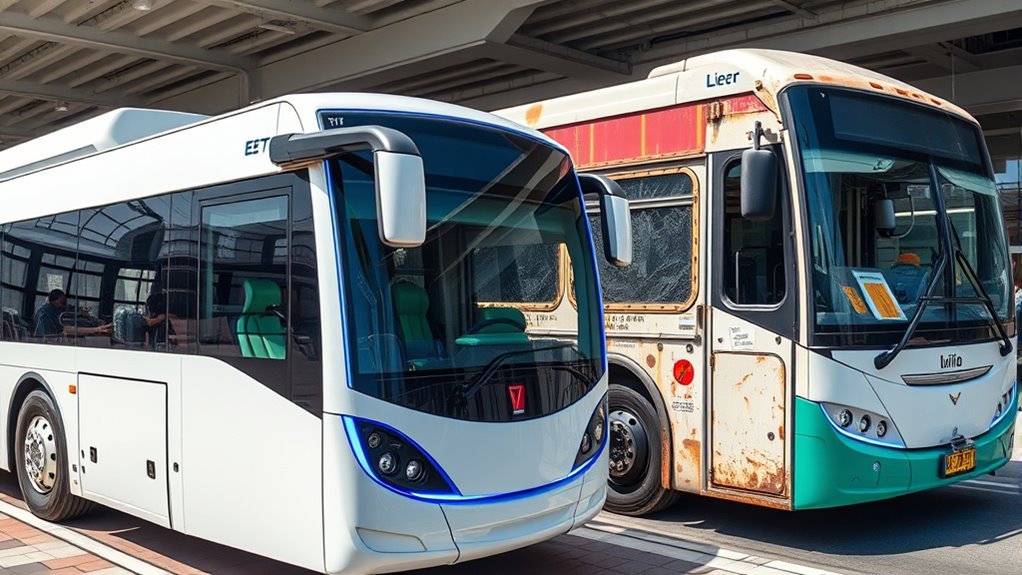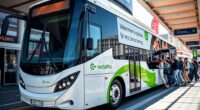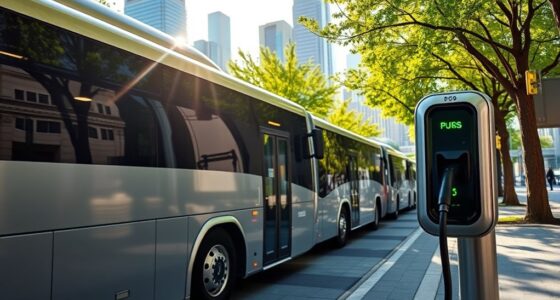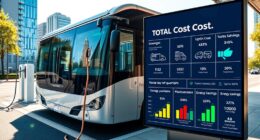When comparing the total cost of ownership for electric buses versus traditional buses, you’ll find electric models have higher upfront costs but lower fuel and maintenance expenses. Over a 10-year lifespan, electric buses typically save around 15% compared to diesel options, thanks to cheaper electricity and fewer repairs. Infrastructure costs are manageable and often offset by long-term savings. To uncover how these factors add up and make electric buses a smart choice, keep exploring the details.
Key Takeaways
- Electric buses typically have higher upfront costs but lower fuel and maintenance expenses over their lifecycle.
- Over a 10-year period, electric buses can be about 15% more cost-effective than diesel options.
- Infrastructure costs for charging stations vary but are offset by long-term savings and technological advances.
- Incentives and subsidies can significantly reduce the initial investment in electric bus fleets.
- Total Cost of Ownership analysis emphasizes long-term savings and sustainability beyond initial purchase price.
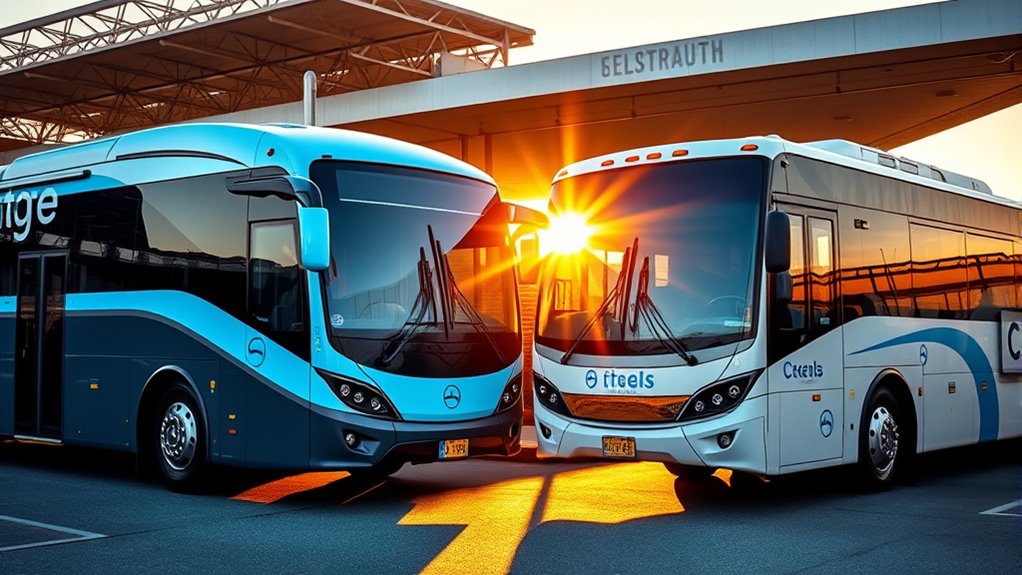
Have you ever considered that the true cost of owning an asset, like a bus, extends far beyond its initial price tag? When you’re managing a fleet, it’s essential to look beyond the purchase price and account for all expenses you’ll encounter over the vehicle’s lifetime. This all-encompassing view, called the Total Cost of Ownership (TCO), includes costs such as fuel, maintenance, infrastructure, and operational expenses.
Understanding TCO allows you to make smarter decisions, ensuring your fleet is cost-effective in the long run. It also provides a solid basis to compare electric and traditional buses, highlighting which option truly offers better value over time.
Initially, electric buses tend to have higher purchase costs compared to diesel or traditional buses. However, this upfront investment is just part of the story. When you examine fuel costs, electric buses significantly cut expenses because electricity is cheaper than diesel. This reduction in fuel expenses can lead to substantial savings over the vehicle’s operational life.
Maintenance costs are another key component; electric buses generally require less maintenance due to fewer moving parts and less wear on components, further lowering your ongoing expenses. But don’t forget, you’ll need to factor in infrastructure costs—installing charging stations and related facilities can add to your upfront investments, especially depending on the size and scale of your fleet. Still, these costs are often offset by the lower operational and maintenance expenses.
When you analyze the entire lifecycle, electric buses tend to be more economical over the long term. Studies show that over a span of 10 years, electric buses can be approximately 15% less expensive than diesel buses. They also outperform compressed natural gas (CNG) buses by about 5%, making them a compelling choice for cost savings.
Traditional procurement decisions, which focus heavily on initial costs, often miss these long-term benefits. By adopting a life cycle perspective, you’re better positioned to maximize your fleet’s cost efficiency and sustainability.
Financial incentives and government support further tip the scales in favor of electric buses. Many regions offer grants, subsidies, or tax incentives that can substantially reduce the financial burden of switching. These incentives are often motivated by environmental goals, aiming to cut carbon emissions and promote cleaner transportation options.
Securing such support not only eases your financial commitment but also aligns your fleet with broader sustainability objectives. Keep in mind, though, that infrastructure costs will vary based on your fleet size and operational needs. Advances in charging technology continue to improve, making infrastructure installation more straightforward and less expensive, which further enhances the long-term value of electric buses. Additionally, understanding projector technology can help optimize your investments in related infrastructure for a home theater setup.
Frequently Asked Questions
How Do Maintenance Costs Compare Over the Bus Lifespan?
You’ll find that maintenance costs for electric buses are generally lower over their lifespan. Electric buses have fewer moving parts, reducing repair needs and costs.
They require less frequent overhauls and benefit from warranties covering early maintenance. Plus, regenerative braking cuts brake repair expenses.
What Is the Environmental Impact of Electric Versus Traditional Buses?
Imagine trading a smoky chimney for a clear, blue sky. Electric buses produce zero tailpipe emissions, drastically cutting urban pollutants and greenhouse gases—up to 90% less than diesel.
They help clean the air you inhale and reduce your carbon footprint, especially when powered by renewables. With lower lifecycle emissions and cleaner operations, electric buses are like a breath of fresh air in your city’s fight against pollution.
How Do Charging Infrastructure Costs Affect Total Ownership?
Charging infrastructure costs directly impact your total ownership expenses. When you plan for infrastructure, consider installation, utility upgrades, and technology choices, as these can vary widely.
Installing multiple chargers at once can reduce costs, but if you need more chargers later, expenses rise. Efficient planning and understanding your site’s electrical capacity assist you in managing costs, ensure smooth operations, and maximize the long-term savings of your electric bus fleet.
Are There Financial Incentives for Adopting Electric Buses?
You might think electric buses are too expensive, but plenty of financial incentives make adoption easier. Federal and state programs offer grants, rebates, tax credits, and low-interest loans that considerably cut upfront costs.
These incentives also support charging infrastructure investments, making the switch more affordable. By leveraging these programs, you can reduce initial expenses, accelerate your move to cleaner transportation, and enjoy long-term savings and environmental benefits.
What Is the Typical Lifespan Difference Between Electric and Traditional Buses?
The current question asks about the lifespan difference between electric and traditional buses. You’ll find that both types typically last between 12 to 15 years, with traditional buses sometimes reaching up to 18 years.
Electric buses have comparable lifespans, but factors like battery degradation and maintenance can influence their durability.
Conclusion
When comparing electric and traditional buses, the total cost of ownership often favors electric options over time. For example, imagine a city switching to electric buses and saving thousands on fuel and maintenance annually. You’ll not only cut costs but also reduce emissions, making your transit system more sustainable. So, if you’re considering your transportation options, remember that investing in electric buses can pay off both financially and environmentally in the long run.
